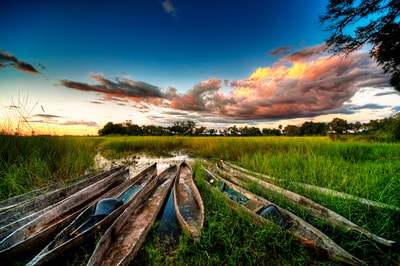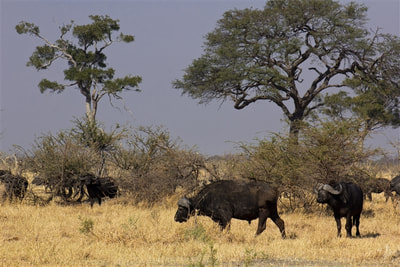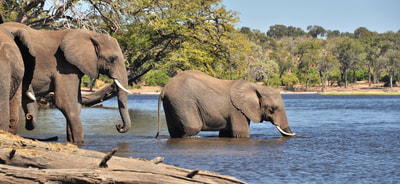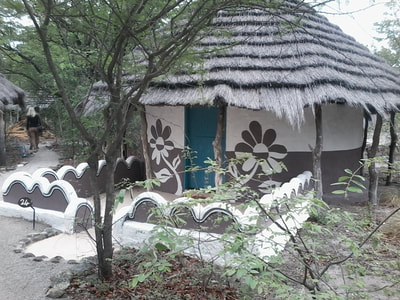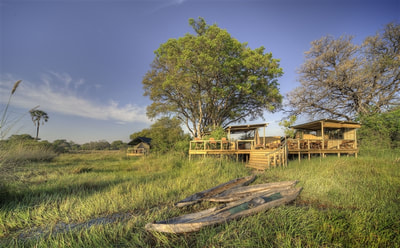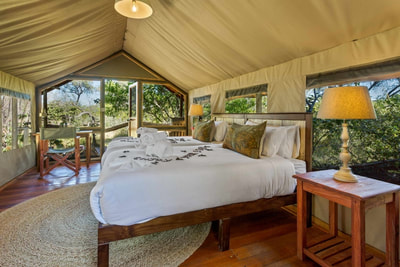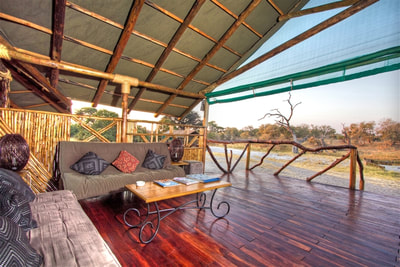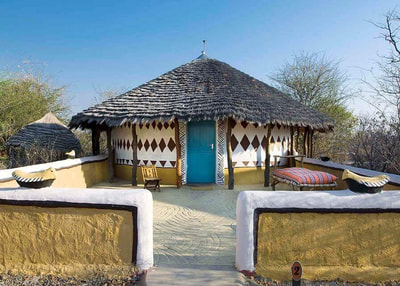|
Highlights...Makgadikgadi, Okavango, Savute, Chobe
|
-
Day to Day
-
Cost
-
The accommodation
-
What's Included
-
Contact Us
<
>
Day 1 Maun/ Makgadikgadi
Arrive at Johannesburg International Airport, where our representative will meet you in the Arrivals Hall and assist you with checking in for your flight to Maun Airport in Botswana. At Maun Airport you will clear customs and collect your luggage. You will be met and driven to Planet Baobab, approximately 2.45 hours’ drive away.
Follow the road pointed out by the giant ant eater and you'll discover the intriguingly named Planet Baobab... This is the Baobab Capital of the World, where the average age of each tree is more than 4000 years, and the boundless lunar landscape of the Makgadikgadi Salt Pans are the size of Switzerland.
This is a quirky place in a quirky part of the world, where we live cheek to tusk with old elephants; sleep in Afro-chic Bakalanga Huts; swim in the largest, coolest pool in the Kalahari; eat the finest pan-African cuisine, and of course, drink something cold with hunters and vagabonds, travellers and locals in the funkiest bar in Africa. It's the coolest desert oasis around – and a part of Africa that few will experience, but all will remember.
Planet Baobab is in the region of Botswana’s mysterious Makgadikgadi Pans, which was once the largest expanse of fresh water on the planet. Today, it's a vast, salt-pan desert of shimmering sand and surreal landscapes so vast you can see the curvature of the earth. It's a harsh and sparse landscape, but one that's beautiful in its desolation. Here, perhaps more than anywhere else in the world, you'll be struck by a feeling of utter, marvellous, isolation.
Day 2 Makgadikgadi
At 6h00, you will set out for Ntwetwe Pan trip, which includes a picnic, along with a visit to the meerkats. Completely habituated to human presence through years of research, you'll get closer than you might think to the cheeky creatures! But just remember, they’re not tame – just used to a non-threatening presence.
Experience the vast remoteness of the Makgadikgadi Pans and Kalahari Desert, a place of endless horizons and four-thousand-year-old inverted trees. The camp itself has been voted as one of the top 10 most extraordinary places to stay in the world by Lonely Planet – and quite rightly so. Shake off the heat of the day and the dust of the desert in the largest, coolest swimming pool in the Kalahari.
Spend some time with the local Batswana people and learn a little about the way of life in this extraordinary part of the world.
Day 3 Okavango Delta
Today you will be road transferred back to Maun Airport, where you will board a light aircraft for your 20 minute flight into Oddballs Enclave Camp, across the Okavango Delta.
On arrival at the Oddballs airstrip you will be met by the Guide who will be looking after you during your stay at Oddballs Enclave Camp (one guide for every two people).
Oddballs Enclave Camp offers a relaxed atmosphere, with the chance to experience one of Africa's last wildlife oases. Oddballs' Enclave is situated on Noga Island, and on the other side of the main channel is the Moremi Game Reserve and Chiefs' Island, which is a beautiful area to explore during your stay.
Day 4 Okavango Delta
Your Guide is a man of the swamp, born and bred. From Oddballs Enclave Camp your Guide will take you out on Walking Safaris - truly the only way to go out on safari, enabling you to be 'at one' with the environment, and obtain stunning views of both the wildlife and bird life of the Okavango Delta. Your Guide will be happy to track and stalk particular animals that you are interested in seeing.
An early morning wake-up, and after some coffee an early morning walk in the Moremi Game Reserve, returning after three hours or so for a hearty breakfast. During the heat of the day you can relax, and then after lunch another excursion by mokoro into the Moremi Game Reserve. Dining by the light of the camp fire under the canopy of the 'African Sky' completes your day. If you are particularly energetic you can go out on a longer walking safari taking a picnic breakfast or lunch with you.
With a maximum of two guests per guide, the freedom to do what you please and when, free of the demands and constraints of other guests, genuine, hand-made dug-out canoes (no fiberglass replicas here), unarmed walking on Chief’s Island and the Moremi Game Reserve, and the opportunity to visit your guide’s village – totally uncontrived and brimming with character.
The area is renowned for its diverse animal and bird life. Guests can expect to see hippos, elephant, buffalo, lion, leopard, crocodile and giraffe. If guests are lucky enough they might see cheetah. There is a variety of antelope species and some endemic species such as tsessebe, red lechwe and sitatunga as well as smaller carnivores, such as spotted hyena, jackals, wild cats, mongooses and honey-badgers etc.
Day 5 Moremi area
After a morning activity and breakfast, you will be chartered from Oddballs Enclave Camp to Khwai airstrip (25 minutes), where your Saguni Camp guide will meet you and transfer you to the Camp.
Saguni Safari Lodge is located in Moremi East in the Okavango Delta.
It nestles on an island of mature riparian trees, typical of the Okavango Delta, and overlooks the Sable River in the beautiful game-rich area of Khwai. The name ‘Saguni’ is a bushman name for Khwai, meaning “an area with abundance of game
and spectacular sights”.
Days 6 and 7 Moremi area
Saguni Safari Lodge offers the ultimate Okavango Delta experience, with a wide range of activities, a beautiful location, diverse wildlife and warm, local hospitality.
The Khwai Concession is a 180 000 hectare reserve situated in the north eastern Okavango adjacent to the Moremi Game Reserve, meaning there is plenty to explore in both areas!
Besides the game drives, which can feature Africa’s big attractions – lion, cheetah, leopard, wild dog, elephant, buffalo, hippo and giraffe, cultural visits, bush walks and mokoro excursions are all on offer at Saguni.
Game Drives in an open safari vehicle allow you to explore some of the varied vegetation this World Heritage site has to offer. The exceptional Safari guides will take you to areas of outstanding game viewing and explain intricacies of the bush wilderness.
Night drives provide for some of the most dramatic and unusual game viewing. The advantage of a night drive is that they provide access to nocturnal species rarely seen during the day. Hippo, Bush Babies, Chameleon’s, Aardvarks and Leopard are more active after dark, and there is a greater probability of seeing them hunt at night. A night drive Safari has a unique and exciting atmosphere as nocturnal animals are bolder than they are during the day. This increases your chances of witnessing that elusive Leopard. Experience the exhilaration of sitting in the middle of a herd of elephants in the moonlight, or the thundering sound of buffalo hooves in the darkness.
On a bush walk, you have the opportunity to observe the smaller things in the fauna and flora, that one would not see on a game drive. Our knowledgeable guides explain about animals tracks, bush skills and natural remedies used by local people in the area.
Experience a tranquil mokoro (traditional dugout canoe) trip with the best and carefully trained specialist guides. Travel along the fascinating Mbudi water channels of Khwai. This stunning area is known as the Sable Alley system of the Khwai river. A mokoro excursion is not to be missed; you travel through the reed and papyrus lined waterways, winding your way around the lagoon. Listen to the bird calls and the tinkling of the reed frog as you discover the local plant and animal life, both large and small.
Trips into the San community of Khwai can be arranged. The San people (or Saan), also known as Bushmen or Basarwa, are members of various indigenous hunter-gatherer people of Southern Africa. As the original inhabitants of Southern Africa, the San lived for millennia as independent hunters and gatherers. Understand more about the original “Bukakhwe culture”, from trance dances to cultural song.
Day 8 Savute
After an early activity and breakfast, you will be chartered to Savuti airstrip, some 35 minutes away.
Camp Savuti epitomises the Botswana safari experience. From the abundant game viewing to the authentic, tented accommodation, this is the traditional way to spend time in one of Africa's most superb wildlife regions.
Visit Camp Savuti to experience the thrill of getting close to top predators and to watch them in their natural habitat from the comfort of an open-air 4x4 vehicle, guided by knowledgeable rangers.
The area is renowned for its large population of bull elephants and visiting Camp Savuti offers the chance of witnessing the unique interaction of the resident predator species. Visit Camp Savuti for an unforgettable experience. Experienced and passionate guides will ensure that visitors leave with irreplaceable memories in wildest Botswana.
The Savuti is a region that is secretly located away from the peak season crowds at the Chobe riverfront. It is the remote home ground of Camp Savuti, positioned on the banks of the Savuti Channel and close to the famous Savuti Marsh.
Upon arrival at Savuti airstrip, guests will be met by a representative from Camp Savuti and driven the last 20-40 minute journey to the camp. This road transfer could be considered more of a game drive, as it traverses through the wilds and there is a likely chance of spotting any number of animals before even arriving at camp.
Camp Savuti is an intimate, tented safari camp in the prime wildlife area of the Savuti Marsh. This traditional, understated camp is beautifully decorated with African-inspired woodwork, cattle skin rugs, and arts and crafts that give the camp an authentic feel.
Day 9 Savute
Camp Savuti is all about its prime positioning on the Savuti Channel. It is an unfenced camp and receives regular wildlife visitors, which gather at the Savuti Channel to drink. Elephants browse the trees in camp, and birds flit between branches, creating a game-viewing paradise right in front of camp.
The experience at Camp Savuti can be described as camping in style. The tented suites are luxuriously adorned with carpeted floors, ample space, en suite bathrooms and private verandas, but the wood, canvas and natural colours keep it in tune with the surroundings. Guests will feel relaxed and at ease with nothing but comfort and exclusivity in their Meru safari tents.
The Savuti Marsh is known as one of Africa's wildlife hotspots; landscape and ecology that supports a wide array of plant, bird and animal life. During the rainy summer months is when the game flocks to the Savuti region. A mass migration of zebra occurs as these striped ungulates arrive in the Savuti to bear their foals.
***Please note that the Savuti Channel is currently not flowing***
The Savuti is one of the best regions in Africa to see the rare and endangered African wild dog. These canines live and hunt in packs and collectively, they are some of the most efficient hunters out there.
Lions are abundant in the Savuti. National Geographic filmmakers, Dereck and Beverly Joubert, have been filming lions and their behaviour in this area for over 2 decades. Years ago, Savuti lions formed huge prides and worked together to take down elephants as prey, and although this behaviour is not seen often any more, there is no telling what could happen in the wild.
Other frequently seen predators are hyena, cheetah, and leopard. Hyena are said to steal up to 20% of all lion kills, and it is well-documented that these two predators are 'eternal enemies'. Cheetahs are highly endangered and they are also very specialised hunters, while leopards are seen hoisting their prey into the trees.
The Savuti's location in the west of the Chobe National Park makes it a home to a great number of mammals. Most significantly, the Savuti boasts a population of elephants quite unlike any other. The marshland and waterways become crowded with elephants during the summer months when the Savuti Channel feeds the land with water.
One of Savuti's biggest claims to fame is the presence of an annual zebra migration between the Linyanti and the Savuti. With the arrival of the rain comes the migration of thousands of zebra from the Linyanti to the Savuti (November). They are not the only ones seeking out the fresh, new grass, and are accompanied by an array of herbivores, like kudu, impala, wildebeest, warthog and hippo. These are only a few mentionables out of the wide variety of mammals, large and small, that are found in the Savuti.
Birding - the Savuti Marsh is a 10 000 sq. km area and alongside its rich wildlife population, the birdlife is very well represented. Colourful flocks of carmine bee-eaters celebrate the rainy season and fly about in large numbers as game vehicles trundle through the long grass. Secretary birds with their long legs and quirky feathers strut along the ground and perch on top of trees; kori bustards can be seen and admired for their huge size; thousands of red-billed queleas take off from tree tops in unison and cast shadows on the ground below them; African fish eagles are iconic and can be seen and heard soaring high above the channels and marshlands.
Ground birds like francolins and guinea fowls chirp noisily as they scuttle along, while water birds like storks, herons, lapwings and kingfishers keep watchful eyes on the rivers and waterways.
Day 10 Northern Chobe
Today you will be chartered to Kasane Airport (55 minutes), where a representative of Bakwena Lodge will be waiting to transfer you to the Lodge, just 20 minutes’ drive away. Bakwena Lodge lies on the banks of the Chobe River, just 1.5km from the spot where Zambia, Zimbabwe, Namibia and Botswana converge.
The Lodge is surrounded by the Chobe National Park and the Chobe Forest Reserve, with the name "Bakwena" meaning 'people of the crocodile", in the local Setswana lingo. All staff originates from the local villages and communities.
Days 11 and 12 Northern Chobe
Activities at Bakwena Lodge mainly take the form of game drives and boat cruises, although these may be substituted for a guided bird walk at the Seboba Recreational Park, a Caracal World of Wildlife Centre visit, or Fishing (tackle included).
Chobe is home to Africa’s largest elephant population with a daily migration of these magnificent pachyderms from their foraging grounds in the Teak forests, to the mighty Chobe to quench their thirst.
Game Drives:
Generally a three hour activity inside the Chobe National Park, early morning offers the best chance to spot some of the shyer big cats, however all times of the day offer unique experiences!
Boat Cruises:
Definitely the most sedate method of game viewing. The Chobe River has one of the highest concentrations of bird species in the world, from the elusive Finfoot to the regal African Fish eagle.
Bird watching:
By boat, on foot or from the comfort of your own deck; there is a wide variety of species to see including: trumpeter hornbills, crested barbets, weavers, Bishop birds, the pin tailed whydah, collared palm thrush and African fin foot.
Fishing:
The Chobe and Zambezi river systems are home to arguably the best fighting fish in the world (pound for pound) – the mighty Tigerfish. The river systems are also home to a number of other worthy angling species, including catfish, pike and Tilapia species.
Guided Bicycle Tours & Village Walks: These are complimentary.
Day 13 Kasane Airport
After breakfast and a morning activity, you will be transferred back to Kasane Airport in time to check in for your scheduled flight back to Johannesburg International Airport.
Arrive at Johannesburg International Airport, where our representative will meet you in the Arrivals Hall and assist you with checking in for your flight to Maun Airport in Botswana. At Maun Airport you will clear customs and collect your luggage. You will be met and driven to Planet Baobab, approximately 2.45 hours’ drive away.
Follow the road pointed out by the giant ant eater and you'll discover the intriguingly named Planet Baobab... This is the Baobab Capital of the World, where the average age of each tree is more than 4000 years, and the boundless lunar landscape of the Makgadikgadi Salt Pans are the size of Switzerland.
This is a quirky place in a quirky part of the world, where we live cheek to tusk with old elephants; sleep in Afro-chic Bakalanga Huts; swim in the largest, coolest pool in the Kalahari; eat the finest pan-African cuisine, and of course, drink something cold with hunters and vagabonds, travellers and locals in the funkiest bar in Africa. It's the coolest desert oasis around – and a part of Africa that few will experience, but all will remember.
Planet Baobab is in the region of Botswana’s mysterious Makgadikgadi Pans, which was once the largest expanse of fresh water on the planet. Today, it's a vast, salt-pan desert of shimmering sand and surreal landscapes so vast you can see the curvature of the earth. It's a harsh and sparse landscape, but one that's beautiful in its desolation. Here, perhaps more than anywhere else in the world, you'll be struck by a feeling of utter, marvellous, isolation.
Day 2 Makgadikgadi
At 6h00, you will set out for Ntwetwe Pan trip, which includes a picnic, along with a visit to the meerkats. Completely habituated to human presence through years of research, you'll get closer than you might think to the cheeky creatures! But just remember, they’re not tame – just used to a non-threatening presence.
Experience the vast remoteness of the Makgadikgadi Pans and Kalahari Desert, a place of endless horizons and four-thousand-year-old inverted trees. The camp itself has been voted as one of the top 10 most extraordinary places to stay in the world by Lonely Planet – and quite rightly so. Shake off the heat of the day and the dust of the desert in the largest, coolest swimming pool in the Kalahari.
Spend some time with the local Batswana people and learn a little about the way of life in this extraordinary part of the world.
Day 3 Okavango Delta
Today you will be road transferred back to Maun Airport, where you will board a light aircraft for your 20 minute flight into Oddballs Enclave Camp, across the Okavango Delta.
On arrival at the Oddballs airstrip you will be met by the Guide who will be looking after you during your stay at Oddballs Enclave Camp (one guide for every two people).
Oddballs Enclave Camp offers a relaxed atmosphere, with the chance to experience one of Africa's last wildlife oases. Oddballs' Enclave is situated on Noga Island, and on the other side of the main channel is the Moremi Game Reserve and Chiefs' Island, which is a beautiful area to explore during your stay.
Day 4 Okavango Delta
Your Guide is a man of the swamp, born and bred. From Oddballs Enclave Camp your Guide will take you out on Walking Safaris - truly the only way to go out on safari, enabling you to be 'at one' with the environment, and obtain stunning views of both the wildlife and bird life of the Okavango Delta. Your Guide will be happy to track and stalk particular animals that you are interested in seeing.
An early morning wake-up, and after some coffee an early morning walk in the Moremi Game Reserve, returning after three hours or so for a hearty breakfast. During the heat of the day you can relax, and then after lunch another excursion by mokoro into the Moremi Game Reserve. Dining by the light of the camp fire under the canopy of the 'African Sky' completes your day. If you are particularly energetic you can go out on a longer walking safari taking a picnic breakfast or lunch with you.
With a maximum of two guests per guide, the freedom to do what you please and when, free of the demands and constraints of other guests, genuine, hand-made dug-out canoes (no fiberglass replicas here), unarmed walking on Chief’s Island and the Moremi Game Reserve, and the opportunity to visit your guide’s village – totally uncontrived and brimming with character.
The area is renowned for its diverse animal and bird life. Guests can expect to see hippos, elephant, buffalo, lion, leopard, crocodile and giraffe. If guests are lucky enough they might see cheetah. There is a variety of antelope species and some endemic species such as tsessebe, red lechwe and sitatunga as well as smaller carnivores, such as spotted hyena, jackals, wild cats, mongooses and honey-badgers etc.
Day 5 Moremi area
After a morning activity and breakfast, you will be chartered from Oddballs Enclave Camp to Khwai airstrip (25 minutes), where your Saguni Camp guide will meet you and transfer you to the Camp.
Saguni Safari Lodge is located in Moremi East in the Okavango Delta.
It nestles on an island of mature riparian trees, typical of the Okavango Delta, and overlooks the Sable River in the beautiful game-rich area of Khwai. The name ‘Saguni’ is a bushman name for Khwai, meaning “an area with abundance of game
and spectacular sights”.
Days 6 and 7 Moremi area
Saguni Safari Lodge offers the ultimate Okavango Delta experience, with a wide range of activities, a beautiful location, diverse wildlife and warm, local hospitality.
The Khwai Concession is a 180 000 hectare reserve situated in the north eastern Okavango adjacent to the Moremi Game Reserve, meaning there is plenty to explore in both areas!
Besides the game drives, which can feature Africa’s big attractions – lion, cheetah, leopard, wild dog, elephant, buffalo, hippo and giraffe, cultural visits, bush walks and mokoro excursions are all on offer at Saguni.
Game Drives in an open safari vehicle allow you to explore some of the varied vegetation this World Heritage site has to offer. The exceptional Safari guides will take you to areas of outstanding game viewing and explain intricacies of the bush wilderness.
Night drives provide for some of the most dramatic and unusual game viewing. The advantage of a night drive is that they provide access to nocturnal species rarely seen during the day. Hippo, Bush Babies, Chameleon’s, Aardvarks and Leopard are more active after dark, and there is a greater probability of seeing them hunt at night. A night drive Safari has a unique and exciting atmosphere as nocturnal animals are bolder than they are during the day. This increases your chances of witnessing that elusive Leopard. Experience the exhilaration of sitting in the middle of a herd of elephants in the moonlight, or the thundering sound of buffalo hooves in the darkness.
On a bush walk, you have the opportunity to observe the smaller things in the fauna and flora, that one would not see on a game drive. Our knowledgeable guides explain about animals tracks, bush skills and natural remedies used by local people in the area.
Experience a tranquil mokoro (traditional dugout canoe) trip with the best and carefully trained specialist guides. Travel along the fascinating Mbudi water channels of Khwai. This stunning area is known as the Sable Alley system of the Khwai river. A mokoro excursion is not to be missed; you travel through the reed and papyrus lined waterways, winding your way around the lagoon. Listen to the bird calls and the tinkling of the reed frog as you discover the local plant and animal life, both large and small.
Trips into the San community of Khwai can be arranged. The San people (or Saan), also known as Bushmen or Basarwa, are members of various indigenous hunter-gatherer people of Southern Africa. As the original inhabitants of Southern Africa, the San lived for millennia as independent hunters and gatherers. Understand more about the original “Bukakhwe culture”, from trance dances to cultural song.
Day 8 Savute
After an early activity and breakfast, you will be chartered to Savuti airstrip, some 35 minutes away.
Camp Savuti epitomises the Botswana safari experience. From the abundant game viewing to the authentic, tented accommodation, this is the traditional way to spend time in one of Africa's most superb wildlife regions.
Visit Camp Savuti to experience the thrill of getting close to top predators and to watch them in their natural habitat from the comfort of an open-air 4x4 vehicle, guided by knowledgeable rangers.
The area is renowned for its large population of bull elephants and visiting Camp Savuti offers the chance of witnessing the unique interaction of the resident predator species. Visit Camp Savuti for an unforgettable experience. Experienced and passionate guides will ensure that visitors leave with irreplaceable memories in wildest Botswana.
The Savuti is a region that is secretly located away from the peak season crowds at the Chobe riverfront. It is the remote home ground of Camp Savuti, positioned on the banks of the Savuti Channel and close to the famous Savuti Marsh.
Upon arrival at Savuti airstrip, guests will be met by a representative from Camp Savuti and driven the last 20-40 minute journey to the camp. This road transfer could be considered more of a game drive, as it traverses through the wilds and there is a likely chance of spotting any number of animals before even arriving at camp.
Camp Savuti is an intimate, tented safari camp in the prime wildlife area of the Savuti Marsh. This traditional, understated camp is beautifully decorated with African-inspired woodwork, cattle skin rugs, and arts and crafts that give the camp an authentic feel.
Day 9 Savute
Camp Savuti is all about its prime positioning on the Savuti Channel. It is an unfenced camp and receives regular wildlife visitors, which gather at the Savuti Channel to drink. Elephants browse the trees in camp, and birds flit between branches, creating a game-viewing paradise right in front of camp.
The experience at Camp Savuti can be described as camping in style. The tented suites are luxuriously adorned with carpeted floors, ample space, en suite bathrooms and private verandas, but the wood, canvas and natural colours keep it in tune with the surroundings. Guests will feel relaxed and at ease with nothing but comfort and exclusivity in their Meru safari tents.
The Savuti Marsh is known as one of Africa's wildlife hotspots; landscape and ecology that supports a wide array of plant, bird and animal life. During the rainy summer months is when the game flocks to the Savuti region. A mass migration of zebra occurs as these striped ungulates arrive in the Savuti to bear their foals.
***Please note that the Savuti Channel is currently not flowing***
The Savuti is one of the best regions in Africa to see the rare and endangered African wild dog. These canines live and hunt in packs and collectively, they are some of the most efficient hunters out there.
Lions are abundant in the Savuti. National Geographic filmmakers, Dereck and Beverly Joubert, have been filming lions and their behaviour in this area for over 2 decades. Years ago, Savuti lions formed huge prides and worked together to take down elephants as prey, and although this behaviour is not seen often any more, there is no telling what could happen in the wild.
Other frequently seen predators are hyena, cheetah, and leopard. Hyena are said to steal up to 20% of all lion kills, and it is well-documented that these two predators are 'eternal enemies'. Cheetahs are highly endangered and they are also very specialised hunters, while leopards are seen hoisting their prey into the trees.
The Savuti's location in the west of the Chobe National Park makes it a home to a great number of mammals. Most significantly, the Savuti boasts a population of elephants quite unlike any other. The marshland and waterways become crowded with elephants during the summer months when the Savuti Channel feeds the land with water.
One of Savuti's biggest claims to fame is the presence of an annual zebra migration between the Linyanti and the Savuti. With the arrival of the rain comes the migration of thousands of zebra from the Linyanti to the Savuti (November). They are not the only ones seeking out the fresh, new grass, and are accompanied by an array of herbivores, like kudu, impala, wildebeest, warthog and hippo. These are only a few mentionables out of the wide variety of mammals, large and small, that are found in the Savuti.
Birding - the Savuti Marsh is a 10 000 sq. km area and alongside its rich wildlife population, the birdlife is very well represented. Colourful flocks of carmine bee-eaters celebrate the rainy season and fly about in large numbers as game vehicles trundle through the long grass. Secretary birds with their long legs and quirky feathers strut along the ground and perch on top of trees; kori bustards can be seen and admired for their huge size; thousands of red-billed queleas take off from tree tops in unison and cast shadows on the ground below them; African fish eagles are iconic and can be seen and heard soaring high above the channels and marshlands.
Ground birds like francolins and guinea fowls chirp noisily as they scuttle along, while water birds like storks, herons, lapwings and kingfishers keep watchful eyes on the rivers and waterways.
Day 10 Northern Chobe
Today you will be chartered to Kasane Airport (55 minutes), where a representative of Bakwena Lodge will be waiting to transfer you to the Lodge, just 20 minutes’ drive away. Bakwena Lodge lies on the banks of the Chobe River, just 1.5km from the spot where Zambia, Zimbabwe, Namibia and Botswana converge.
The Lodge is surrounded by the Chobe National Park and the Chobe Forest Reserve, with the name "Bakwena" meaning 'people of the crocodile", in the local Setswana lingo. All staff originates from the local villages and communities.
Days 11 and 12 Northern Chobe
Activities at Bakwena Lodge mainly take the form of game drives and boat cruises, although these may be substituted for a guided bird walk at the Seboba Recreational Park, a Caracal World of Wildlife Centre visit, or Fishing (tackle included).
Chobe is home to Africa’s largest elephant population with a daily migration of these magnificent pachyderms from their foraging grounds in the Teak forests, to the mighty Chobe to quench their thirst.
Game Drives:
Generally a three hour activity inside the Chobe National Park, early morning offers the best chance to spot some of the shyer big cats, however all times of the day offer unique experiences!
Boat Cruises:
Definitely the most sedate method of game viewing. The Chobe River has one of the highest concentrations of bird species in the world, from the elusive Finfoot to the regal African Fish eagle.
Bird watching:
By boat, on foot or from the comfort of your own deck; there is a wide variety of species to see including: trumpeter hornbills, crested barbets, weavers, Bishop birds, the pin tailed whydah, collared palm thrush and African fin foot.
Fishing:
The Chobe and Zambezi river systems are home to arguably the best fighting fish in the world (pound for pound) – the mighty Tigerfish. The river systems are also home to a number of other worthy angling species, including catfish, pike and Tilapia species.
Guided Bicycle Tours & Village Walks: These are complimentary.
Day 13 Kasane Airport
After breakfast and a morning activity, you will be transferred back to Kasane Airport in time to check in for your scheduled flight back to Johannesburg International Airport.
Included:
Not Included:
- Scheduled flight from Johannesburg to Maun Airport
- Road transfer from Maun Airport to Planet Baobab
- 2 Nights at Planet Baobab in an en-suite Bakalanga Hut
- All meals, a Baobab Walk and Sundowner Drink, a full day Ntwetwe Pan excursion and park entry fees
- Road transfer from Planet Baobab back to Maun Airport
- Air charter from Maun to Oddballs Enclave Camp
- 2 Nights at Oddballs Enclave Camp in an en-suite tent
- All meals, local drinks, privately-guided activities, park fees and laundry
- Air charter from Oddballs Enclave Camp to Saguni Safari Lodge
- 3 Nights at Saguni Safari Lodge in an en-suite tent
- All meals, local drinks, guided activities, park fees and laundry
- Air charter from Saguni Safari Lodge to Camp Savuti
- 2 Nights at Camp Savuti in an en-suite tent
- All meals, local drinks, guided activities, park fees and laundry
- Air charter from Camp Savuti to Kasane Airport
- Road transfer from Kasane Airport to Bakwena Lodge
- 3 Nights at Bakwena Lodge in an en-suite chalet
- All meals, select local drinks, guided activities, park fees and laundry
- Road transfer from Bakwena Lodge to Kasane Airport
- Scheduled flight from Kasane back to Johannesburg International Airport
Not Included:
- Travel and medical insurance
- Visa requirements
- Premium brand drinks
- Gratuities and items of a personal nature
